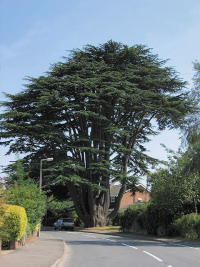Aperfield
Aperfield, Bromley
Much of what is now Biggin Hill was once known as Aperfield – and some maps still refer to the eastern side of the district by this name

Originally Appuldre (‘apple tree’), this place’s name grew to Apuldrefeld (‘apple tree field’) and then contracted to its present form.
Like much of what is now outer-south-east London, the estate was given by William the Conqueror to his brother, Bishop Odo of Bayeux. Two centuries later lord of the manor Henry de Apuldrefeld obtained the right to hold a fair and market here.
In the 17th century Aperfield was in the possession of the Earl of Sussex, who leased it to a widow named Ann Brasier. The manor’s last owner was Frederick Henry Dougal of Wandsworth, who bought it at auction in 1895. He divided his new property into small plots, which he sold cheaply in 1901, setting in train the disjointed creation of Biggin Hill. Dougal died in 1905.
At the centre of the manor stood Aperfield Court, a second-rate mansion with a first-rate tree of biblical proportions in its garden. The property was requisitioned by the War Office in 1917 and a powerful wireless transmitter was installed in the grounds for communications with fighter planes flying out of Biggin Hill aerodrome.
The wider district had no collective identity at first. The hamlet of Biggin Hill was focused on the Black Horse Inn and the junction of Main Road with Jail Lane while neighbouring Aperfield lay a short distance to the south, extending south-eastwards from the junction of Main Road with what became Church Road after the first incarnation of St Mark’s was erected. As the suburb expanded in all directions between the wars, maps began to show Biggin Hill as the name of the whole place, with Aperfield as a subsidiary locality.
Aperfield Court was demolished in 1920. “The house of Aperfield is not long vanished: among the desolate remnants of its demesne there survives one majestic conifer which should be allowed immunity against the assaults of bungalow-plotters,” wrote Osbert and Eleanor Howarth in their History of Darwin’s Parish in 1933. And lo, it came to pass that this cedar of Lebanon was saved. It now finds itself located on Aperfield Road, as shown in the photograph above and marked by a big pink pin on the map below. In 1998 the Aperfield Cedar became one of the inaugural ‘great trees of London’, which were chosen to receive commemorative green plaques in a scheme intended to recognise and protect the capital’s arboreal heritage.
The Aperfield Inn (which only recently adopted this name) stands a mile to the south-east of what was once the village of Aperfield, in the locality variously known as South Street or Westerham Hill – or as an extension of Biggin Hill or Westerham. The pub’s sign features the Aperfield Cedar.
